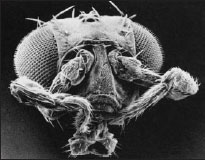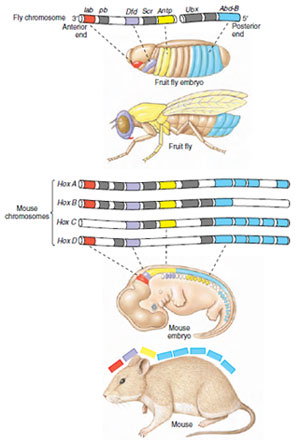The Homeotic Genes
The Homeotic Genes
As development proceeds, gene expression
must be regulated to ensure
the orderly development of the embryo.
Among the earliest and most
important genes to be expressed are
those that control the overall body
plan of the embryo. Recently much
attention has been focused on the homeotic genes (Gr. homoios, to be
like, or resembling) of fruit flies, which
specify the identity of segments and
assure that structures such as legs and
wings and antennae develop in the
right place. When mutated, homeotic
genes produce dramatic effects on
body organization, such as the replacement
of a body part with a structure
normally found elsewhere in the body
(Figure 8-16). It soon became evident
that such mutations were affecting
master genes that controlled the expression
of many subordinate genes.
During the cloning and sequencing of
homeotic genes, a 180-nucleotide DNA
sequence was discovered, called the homeobox. Homeoboxes were soon
found in the genomes of other arthropods,
and in animals as diverse as
cnidarians, nematodes, annelids, sea
urchins, and vertebrates. An important
characteristic of the homeobox is that
the 180-nucleotide sequence is highly
conserved, that is, the sequence is
remarkably similar in homeobox genes
of different species, even those widely
separated in evolutionary origin. For
example, the homeobox in a mouse
homeotic gene shares two-thirds of its
base pairs with a homeobox in one of
the fruit fly homeotic genes. Genes
carrying the homeobox sequence are
all expressed during development, suggesting
that the homeobox performs a
broadly essential function.
All proteins coded by homeobox genes contain a highly conserved 60- amino acid sequence called the homeodomain. Evidence suggests that all homeodomain proteins studied are regulatory proteins that recognize and bind to specific promoter sequences of DNA in the genes regulated by the homeotic genes. In this way the homeodomain proteins switch subordinate genes on or off at specific times during development.
Much of our understanding of homeoboxes
comes from studies of
homeobox control of segmentation
in insects, especially fruit flies. Researchers
discovered that the homeoboxcontaining
genes are lined up along a
fly’s third chromosome in precisely
the same order as segments of the
fly’s body that they control. Genes at
the beginning of the cluster produce
proteins that control the formation of
the upper body; those farther along
the cluster control development of the
upper abdomen; and those at the end
of the cluster control development of
the lower abdomen (Figure 8-17). Mice
and humans have four clusters of
homeobox-containing genes, each cluster
located on a separate chromosome.
Researchers who first revealed the order
of these genes in mice discovered that
they are homologous to the fruit fly’s
homeotic genes: they are structurally
similar, they match each other in order,
and they obey the same rule of order of
expression.
That is, genes located near
one end of the
cluster are expressed in
the upper half of the mouse body
while
those at the other end of the cluster are
expressed in the lower half of the body
(Figure 8-17).
Amphibian development provides an excellent example of how homeotic genes control development. In amphibians, one homeotic gene encodes a homeobox protein that controls expression of target genes that direct formation of the anterior spinal cord. When researchers injected antibodies directed against the homeobox protein, thus blocking its action, the structure that should have become spinal cord developed into hindbrain instead. The portion of spinal cord that should have formed was missing altogether (Figure 8-18), because the genes that directed its development were not activated in the absence of the homeobox regulatory protein.
The amazing similarity of homeobox complexes in animals as phylogenetically distant as nematodes and mammals suggests that the cluster arose very early in the history of life and was in place in the common ancestor of all Metazoa. Homeobox-containing genes may be considered a defining character, or, in the language of cladistics, a synapomorphy of the animal kingdom. Their function was to specify the fundamental anteroposterior axis of an early metazoan. Once such a complex had evolved, it could be modified to produce new body shapes for the different animal phyla.
 |
| Figure 8-16 Head of a fruit fly with a pair of legs growing out of head sockets where antennae normally grow. The Antennapedia homeotic gene normally specifies the second thoracic segment (with legs), but the dominant mutation of this gene leads to this bizarre phenotype. |
All proteins coded by homeobox genes contain a highly conserved 60- amino acid sequence called the homeodomain. Evidence suggests that all homeodomain proteins studied are regulatory proteins that recognize and bind to specific promoter sequences of DNA in the genes regulated by the homeotic genes. In this way the homeodomain proteins switch subordinate genes on or off at specific times during development.
 |
| Figure 8-17 Homology of homeobox genes in insects and mammals. These genes in both insects (fruit fly) and mammals (mouse) control the subdivision of the embryo into regions of different developmental fates along the anterior-posterior axis. The homeobox-containing genes lie on a single chromosome of the fruit fly and on four separate chromosomes in the mouse. Clearly defined homologies between the two, and the parts of the body in which they are expressed, are shown in color. The open boxes denote areas where it is difficult to identify specific homologies between the two. |
 |
| Figure 8-18 How the inhibition of a homeodomain regulatory protein alters normal development of the central nervous system of a frog tadpole. When the protein (encoded by a homeobox DNA sequence known as X1Hbox 1) was inactivated by antibodies directed against it, the area that should have become anterior spinal cord transformed into hindbrain instead. |
Amphibian development provides an excellent example of how homeotic genes control development. In amphibians, one homeotic gene encodes a homeobox protein that controls expression of target genes that direct formation of the anterior spinal cord. When researchers injected antibodies directed against the homeobox protein, thus blocking its action, the structure that should have become spinal cord developed into hindbrain instead. The portion of spinal cord that should have formed was missing altogether (Figure 8-18), because the genes that directed its development were not activated in the absence of the homeobox regulatory protein.
The amazing similarity of homeobox complexes in animals as phylogenetically distant as nematodes and mammals suggests that the cluster arose very early in the history of life and was in place in the common ancestor of all Metazoa. Homeobox-containing genes may be considered a defining character, or, in the language of cladistics, a synapomorphy of the animal kingdom. Their function was to specify the fundamental anteroposterior axis of an early metazoan. Once such a complex had evolved, it could be modified to produce new body shapes for the different animal phyla.




